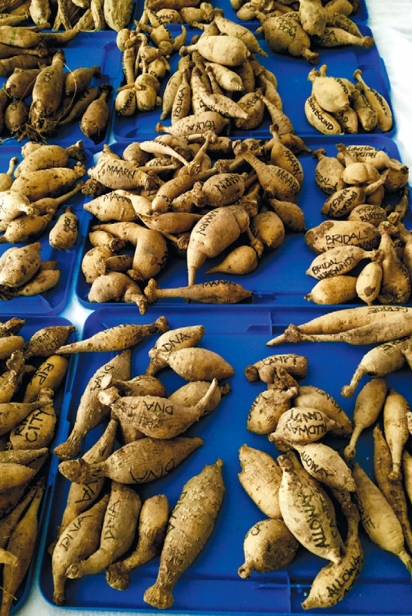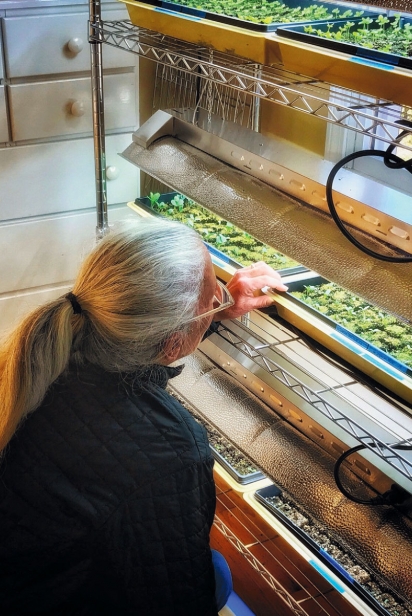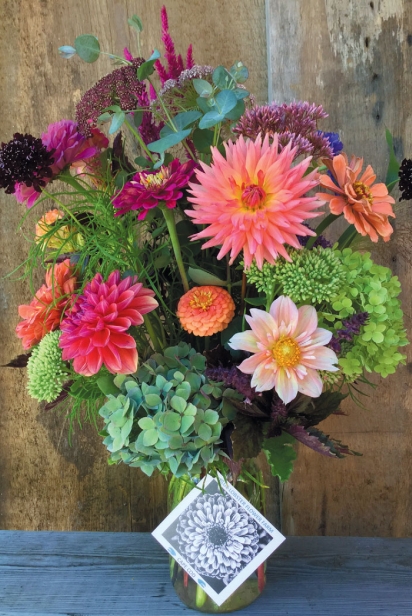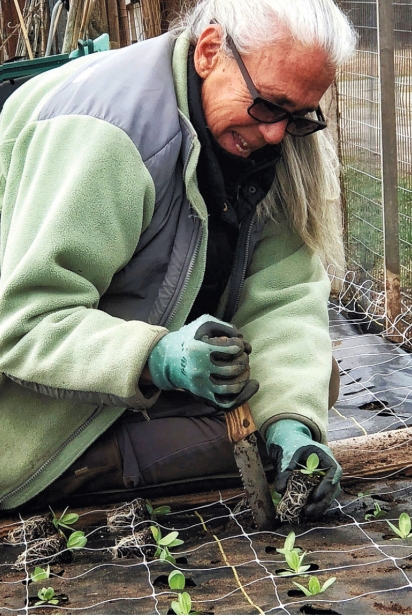Peddling Petals
Blue Lobster Flower Farm
95 different flower species and 500 dahlia bulbs, all grown on a half-acre plot. Three years into her retirement, Meryl Gartside is anything but retired.
“I’ve had about four careers, and my husband and I have raised two children,” says Gartside. “I didn’t want to hang it up yet.”
The blue lobster, the moniker she chose for her business, has something in common with their 40-year marriage. While not quite the odds as the one in 2,000,000 chance of finding a bright cerulean crustacean, “We have a long partnership,” says Gartside. “A real rarity these days.
”Deciding on a move to the Cape for their next chapter, the pair literally dug right in and got involved, agreeing to administer the Brewster Community Gardens located on Lower Road, just off Route 6A. Their activism earned them the honor of Brewster’s 2018 volunteers of the year.
Soon after, they committed to coordinating the Lower Cape Children’s Garden, adjacent to the community plots. Open to 14 kids aged 8-12 from Brewster to Provincetown, this program, begun in 2006, pairs each child with a member of the Association of Cape Cod Master Gardeners. “They guide them in getting their green thumbs on for an hour and a half every week. Soon they’re picking, and even better, eating radishes, celery and all the other veggies they can raise,” says Gartside. “These are the gardeners of our future.”
The past few years Gartside has added a new twist to their curriculum; flowers. “We donate all we grow to the Flower Angels, a non-profit that gathers arrangements from funerals, events, weddings and parties, and redesigns them to share with the elderly and disabled.”
Gartside’s own botanical devotion was born in her mother’s rock garden. “I was so fond of that spot and infatuated with it by a very young age, I was hooked. A few weeks ago when I was visiting her at a local residence, my mother was one of the recipients of a Flower Angels’ bouquet,” says Gartside. “The circle was completed.”
Delicate hellebores, one of the first perennials to appear after winter, are Gartside’s favorite, and they bloomed in her yard when we met in early spring. Paper-thin petals in deep burgundy and smoky black-violet fluttered in the cool breeze near others of pale celadon. Gartside carefully turned one blossom over, showing the exquisite patterning hidden from view on its underside.
“What’s unexpected is the demand here for local flowers,” says Gartside. “People are behind me. It’s exciting that I had to double my field production in only the second year.”
Blue Lobster showcases their weekly harvest at Eat Cake 4 Breakfast, a specialty bakeshop on Underpass Road in Brewster. They also supply area florists, including the flower bar of the new Plant Work Shop in Orleans. Offering buckets of blooms to DIY brides, Gartside works with an associate who fashions bouquets and floral pieces for weddings, parties and other events. Customers can order flowers directly and meet at a pick-up spot. Next year Blue Lobster may launch a subscription service on alternating weeks because their flowers are so long lasting.
Hands-on from soil prep to final detail, Gartside relishes planting each seed, sorting every bulb, staking, netting, harvesting, assembling and designing, plus the marketing and distribution. Yet the foremost reason she does it all is the process of trying to achieve her goals; this intrigues and pushes her to learn more. Gartside praises the expanding community of dedicated flower farmers who generously share their best practices through websites, podcasts and blogs.
Take sweet peas. On growing the delicate ruffled blossoms last year, Gartside says, “It was a great first attempt, but I didn’t plant enough. They don’t ship well so they’re just a wonderful addition to bring to Cape Cod florists.”
This year she’ll try the cordoning method. Sweet pea seedlings will be staked about nine inches apart. Removing all side growth will force them to lengthen vertically. When their main stems reach the top of the six-foot poles, the vines will be released, and each one trailed along the ground and refastened, three poles to the left, where they will climb again. Cordoning is said to produce longer, straighter, more bouquet-worthy stalks, with fewer, but far more dramatic, blooms. “Sweet peas are just the happiest surprise, the more I grow, the more I fall in love with them.” says Gartside. “Just magical.”
Graphic design was her initial field of professional study, and she followed that career path while living with her family in Boston, Houston and Great Britain. “Weekends, especially in Europe, there was always another incredible garden in England or France that we could visit,” reminisces Gartside.
Returning stateside, she felt the pull to move in a new direction. Earning her Master Gardener Certification in 1993 was followed by gaining a Landscape Design Certification at Radcliffe College, doing much of the study hands-on at the New York Botanical Gardens. “I got a job at a family-owned garden center, and ended up staying for 19 years,” says Gartside. “I expanded what eventually became a huge department of their landscape business.”
A few years into Cape living, the urge to create a flower farm grew stronger. “I love flowers and it’s a universal feeling. I’ve never met anyone who didn’t like them. More and more I thought about growing commercially,” says Gartside.
Land options were meager, with her own home sited atop a slope with little growing space, and Cape real estate costs prohibitive. Then a friend offered her the use of a quarter acre, just a ten-minute drive from her home. Witnessing her initial success, he doubled the plot size for her second growing year. “It was a field, maybe with a broken car to move, but wide open land, no trees, just lots and lots of sun,” says Gartside. “This is the most generous friend ever.”
Grooming the property into a viable farming operation required time and capital. Gartside gently pried her husband from the fly-fishing he so dearly loves. Together they removed eight inches of soil, replaced it with loam, and fenced the perimeter, thwarting the local turkeys, voles and deer. “Rob became an irrigation expert, laying down drip lines, and overlaying the surface with the rolls of black weed barrier cloth. Then this spring we hit rewind and did it all over again, to extend our total growing area.” says Gartside, adding, “He’s my guy.”
Land prepped, Gartside uses a multi-tiered approach to achieve a spectacular diversity of blooms. Some, like dahlias, are planted every year with their tubers dug up and stored each fall for use the next growing season. One small area of the field is peppered directly with seeds, but most of the flowers are started meticulously in her tiny guest room. Now home to racks of seeded trays poised under grow bulbs, the first leaves of tiny plants in an array of green tones stretch towards the light.
Once the Cape spring has warmed, these tender starts move to cloth-draped mini-tunnels on Gartside’s back porch. She can prop open the covers on warm days. Simply designed and made by her husband, they function beautifully, allowing the young stems to gradually get used to the sun and wind exposure they'll face later at the farm.
The farm’s debut year included Gartside planting trials of different flower species for the future. “Now I want to have larger quantities of many of those. I’ll sow them successively every few weeks to have a longer window of availability of each.”
Blue Lobster’s stunning social media presence is fired by Gartside’s photography skill and aesthetic. Trying to classify her palette is challenging. Coupling diverse colors and textures, she loves it all, shying away only from too much pink, a nod, she imagines, to an overload of the hue in her childhood bedroom. Gartside says, “I’m definitely not about matchy matchy.”
Nearly all the added square footage of the farm will be devoted to dahlias, which for Gartside, run a tight second only to hellebores. “Last year I was picking armfuls of gorgeous dahlias from July well into November. Hopefully the weather this fall will be as mild.”
Encouraged by Blue Lobster’s reception last year, Gartside plans on harvesting three times weekly this season. She says, “People are noticing locally grown products more and more. These join a growing trend of being healthier than those sprayed with pesticides and chemical fertilizers. They’re fresher than other options, smell really, really, lovely, and now area florists can access more varieties.”
“I love growing flowers. Now I have the freedom to do what I want to do. My husband and I thought we’d move to a warmer climate,” says Gartside, smiling, “but we wanted a different sort of retirement.”
Late bloomers, indeed.
508-896-3464 / bluelobsterflowerfarm.com










